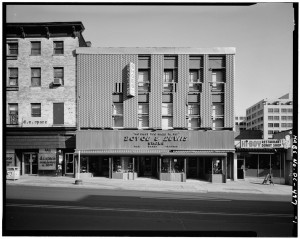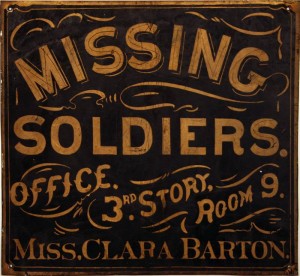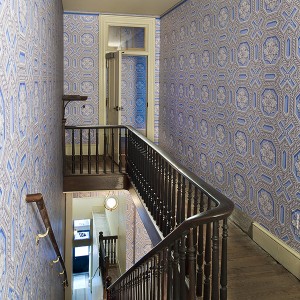Our Story
In 1996, Richard Lyons, an employee of the General Services Administration (GSA), and his partner were on a routine inspection of 437 7th Street, a rundown building slated for demolition.

Behind the modern facade of Boyce and Lewis shoe store, lurked the incredible story of Clara Barton’s roots. Image courtesy of the Library of Congress.
While exploring the third floor, Richard felt something (or someone) tap his shoulder. He turned around and saw an envelope hanging out of the slats of the ceiling.
The envelope, addressed to Edward Shaw, was clearly very old and caught Lyons’ interest. He grabbed a ladder in order to explore the attic and see what else might be lurking there.
What Lyons found was a treasure trove of artifacts—over a thousand objects in all. Among them was a sign that read “Missing Soldiers Office, Office 3rd Story Room 9, Miss Clara Barton.” These were the rooms where Clara Barton had lived and worked during the Civil War.
Lyons’ discovery sparked two decades of hard work and collaboration to save the building and turn it into the Clara Barton Missing Soldiers Office Museum.

The original Missing Soldiers Office sign that Lyons discovered in the attic. Courtesy of the U.S. General Services Administration
The third floor rooms had gone unchanged for almost a hundred years. In 1911, reactions to the Triangle Shirtwaist Fire ushered in a new wave of fire safety legislation. At the time, rather than pay to get the entire building up to code, the landlord simply boarded up the third floor and continued to rent the first two floors as commercial and professional spaces. While the stores below occasionally used the third floor for extra storage, the rooms went both unaltered and uncared for until Lyons discovered them. The GSA worked with experts and artisans to restore the third floor to how Clara would have seen it.
In 2007, the National Museum of Civil War Medicine (NMCWM) partnered with the GSA. While the GSA owns the building, the NMCWM runs the museum.
In July 2015, the museum officially opened to the public. Visitors will have the opportunity to take a guided tour through the preserved rooms where they will discover how Miss Clarissa Barton, Patent Office employee, became the Clara Barton, a household name and the “Angel of the Battlefield.”
- Before
- After



